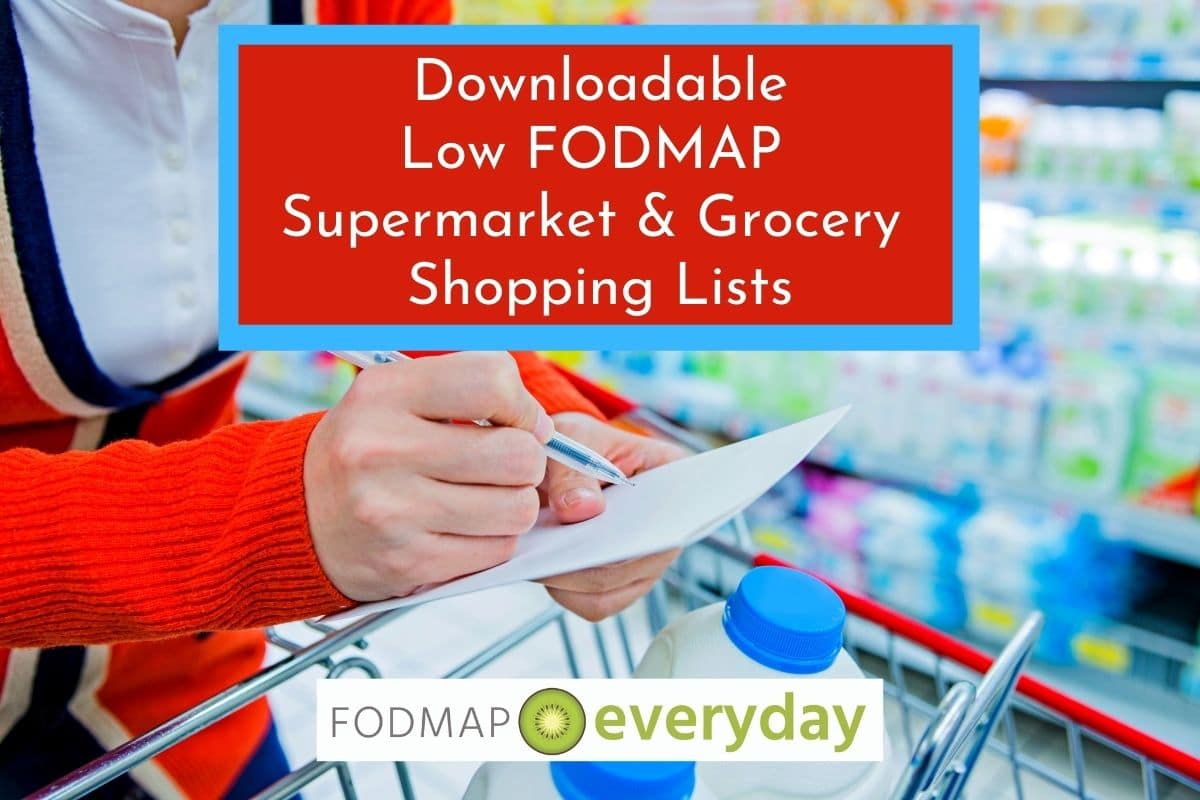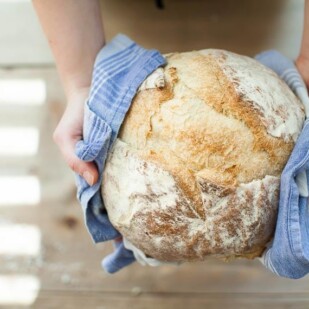If you are following the low FODMAP diet then the #1 question you have is, what can you eat? This article explains how to tell if any food is potentially low FODMAP.
It takes some attention to detail – and yes, some studying – but we want to give you the information you need to be able to follow the low FODMAP diet to the best of your ability.
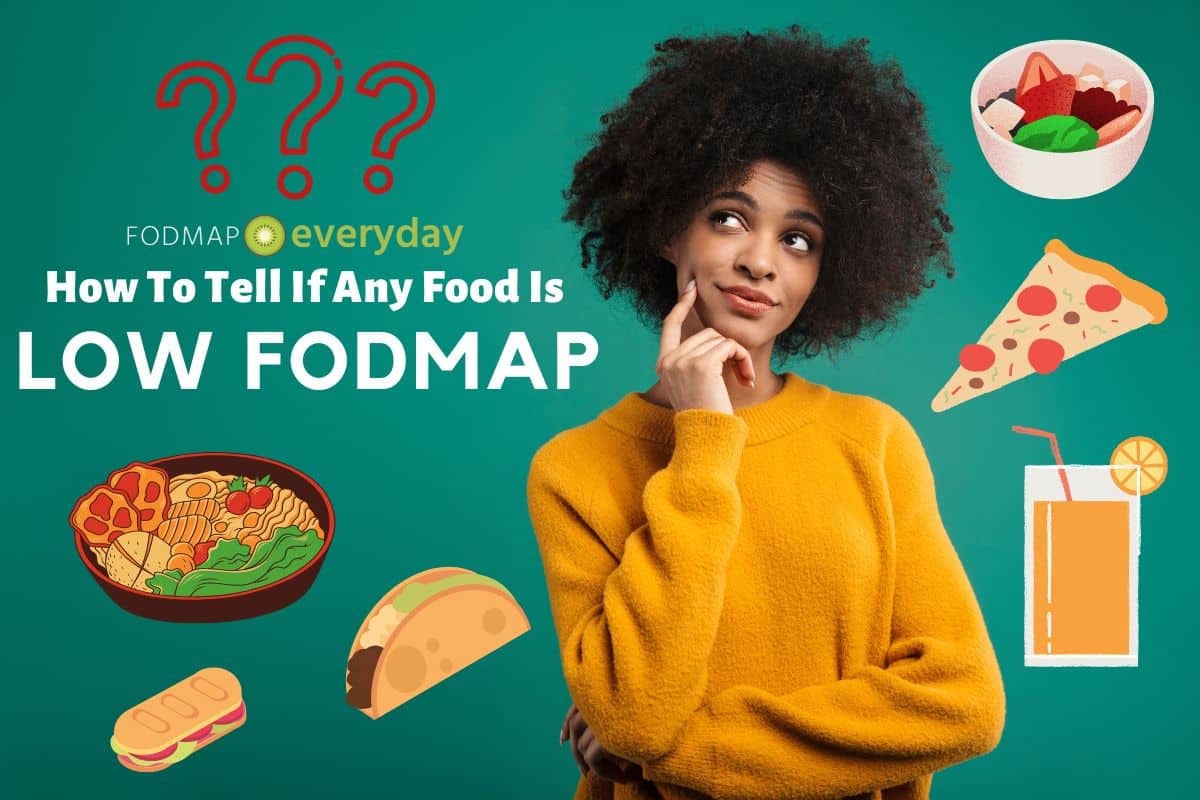
What Are FODMAPs?
First things first: what are FODMAPs? We have a full explanation in our article, What Are FODMAPs? We suggest that you read that article, but what you need to know for now is that FODMAPs are carbohydrates and therefore, if a food contains carbs, it has to be lab tested in order to determine if it contains FODMAPs, and if so, which FODMAPs are present, and what quantity they are in per serving.
…if a food contains carbs, it has to be lab tested in order to determine if it contains FODMAPs, and if so, which FODMAPs are present, and what quantity they are in per serving.
There are several types of FODMAPs: Oligosaccharides, Disaccharides, Monosaccharides and Polyols, and these can be detected in lab tests. You cannot tell if a food contains FODMAPs by looking at it or by making extrapolations.
Can Scanner Apps Help?
They can – if used correctly. Developers of scanner apps, such as Fig and Spoonful, suggest that you use the Monash app alongside for best results. We think they can be very helpful, if used correctly. Please read more in this article, for specifics.
So, what is a FODMAPer to do?
Dietitians Are Key
Statistically and anecdotally we know that working with a FODMAP trained Registered Dietitian (RD) is the most direct route to success, but even if you are working with one, you are on your own the majority of the time and need to brush up on the diet yourself.
Statistically and anecdotally we know that working with a FODMAP trained Registered Dietitian (RD) is the most direct route to success
Use Two Specific Smartphone Apps
One of the very first things you can do to help yourself on this journey is to use the Monash University Low FODMAP Diet App™ and The FODMAP Friendly App.
As we mentioned, foods need to be lab tested to determine FODMAP content. Luckily, the researchers who developed the diet, at both Monash University and FODMAP Friendly, conduct lab testing and publish the results in their smartphone apps of both prepared products as well as raw ingredients.
We have five inter-linked articles that will take you through all the basic info you need:
- Monash University Lab Testing Explained
- FODMAP Friendly Lab Testing Explained
- How To Use The Monash University Smartphone App
- How To Use The FODMAP Friendly Smartphone App
- When Monash University & FODMAP Friendly Lab Test Results Differ
GET THESE APPS!
Everyone following the low FODMAP should have these apps. Period. No excuses. Our team of FODMAP trained Registered Dietitians (RDs) uses them, and so should you. The quickest, easiest most reliable way to tell if a raw ingredient or prepared food product contains FODMAPs is to refer to the Monash University Low FODMAP Diet App™ or the FODMAP Friendly App.
The quickest, easiest most reliable way to tell if a raw ingredient or prepared food product contains FODMAPs is to refer to the Monash University Low FODMAP Diet App™ or the FODMAP Friendly App.
Let’s say you are wondering about bananas. You have heard conflicting things. You found a Pinterest pin that said one thing; your doctor’s office gave you a handout that said something else. You saw yet another conflicting statement in a Facebook group. How do you tell which is the correct information, if any?

YOU CHECK THE APPS. Monash University and FODMAP Friendly are primary resources. They are the ones doing the actual lab tests and research. Everything they report is evidence based. Their apps contain lab test results of raw ingredients – from fruits and vegetables, to cheeses, sweeteners, grains and more – and prepared products such as generic and brand-name salsas, pasta sauces, breads, cereals, snack bars,cookies, crackers, chips and many other foods.
Monash University and FODMAP Friendly lab results do not always agree, but this is not a problem – it does not mean that one is wrong. We explore this in depth in the article, When Monash University & FODMAP Friendly Lab Test Results Differ.
Primary Resources That Are Trustworthy
The lab test results reported by both Monash University and FODMAP Friendly are reliable and up to date. We do not support other FODMAP apps because they are deriving their information from these primary sources and are often out-of-date, present the data incorrectly and typically lack the nuances of the information necessary to fully and correctly understand what is being presented.
Neither Monash University nor FODMAP Friendly share or license their API (Application Programming Interface), which means that the information is proprietary and not directly shared. Got to the sources for the information. Get these apps.
What If A Food Is Not Listed In The Apps?
There are four answers to this very common question.
Number 1: Rely On Lab Testing
If an item is not in the apps as a stand-alone item, then it has not been individually lab tested for FODMAPs and publicly reported. Period. This means that No One Knows What The FODMAP Content Is. Please don’t ask your Registered Dietitian. Don’t ask us in the Facebook groups. No One Knows. (The exceptions are pure proteins and fats, which contain no FODMAPs).
Please note that there is a huge difference between whether something is low FODMAP and whether it is unlikely to trigger digestive upset. Please read our article, Ask The Right Question: Is It Low FODMAP or Can I Tolerate This? This article here pertains to foods that are lab tested and determined to actually be low FODMAP.
Number 2: Study Ingredient Lists Of Lab Tested Prepared Foods
If an ingredient is not listed within the apps as a stand-alone entry but is used in a lab tested and certified product, then that is helpful information. Let’s look at two ingredients that are often asked about.
Are Monk Fruit and Erythritol Low FODMAP? Yes!
As examples, there are several lab tested and low FODMAP products that contain monk fruit and erythritol. For instance, The Good Chocolate brand has several certified products, like their Signature Dark Chocolate Square, that is lab tested and certified low FODMAP at a serving size of 11 g.
So even though erythritol is not a line item by itself on either app, it is within this (and other) certified products, which tells us that some amount of erythritol is low FODMAP.
O’Fit Vanilla Vegan Protein Blend contains monk fruit extract (as do many other certified products). This protein powder is certified low FODMAP in 25 g portions. Again, even though monk fruit is not a line item in either app, this product’s certification tells us that some amount of monk fruit extract it is low FODMAP.
You will know if a product is lab tested and certified because it will sport one of these icons shown below on the label. If you have a product that features one of these icons, then the product is guaranteed to be low FODMAP at the recommended serving sizes – even if it contains “high” FODMAP ingredients.
We have an article for you: How To Read A Low FODMAP Certified Food Product Label.
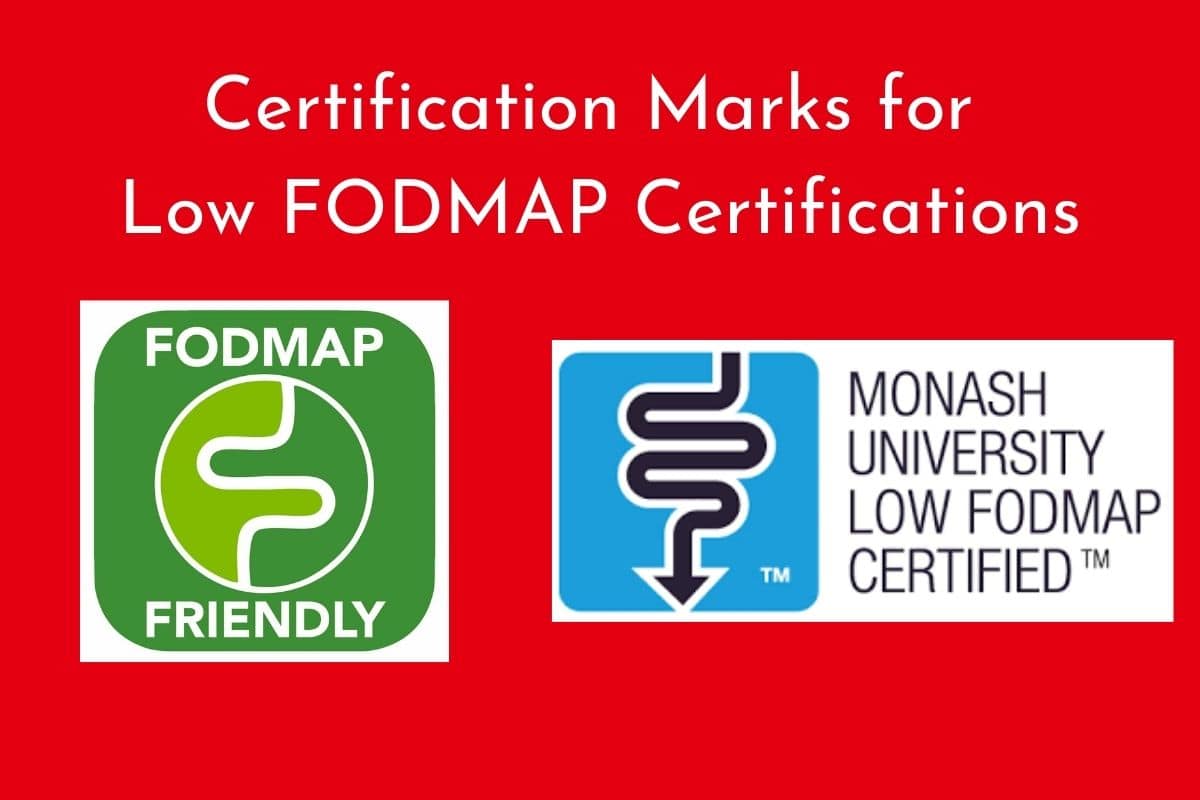
As with so much in the FODMAP universe, amounts – as in serving size – count!
Garlic, Rye and Apple Juice – Oh My!
We know this can be confusing and at first, if you see a product that contains garlic, you might automatically think it is high FODMAP, but that is not necessarily so. Remember, this is a “low” FODMAP diet, not a “no” FODMAP diet.
A product might contain garlic, like San J Thai Peanut Sauce; or rye flour, like Alpine Breads Natural Sourdough Sour Rye; or apple juice concentrate and dried blueberries, like Fody Blueberry Almond Snack Bars; or pea protein like in HUM Core Strength protein powder.
Or how about sweetened condensed milk and glacé cherries? They are in Kez’s Gluten Free Choc Peanut Florentines. Fermented coconut blossom nectar? It’s in Niulife Coconut Aminos Sauces. Ashwagandha is an ancient Indian herb; it’s in Goli Nutrition Gummies.
All of these commercially prepared products are all lab tested and certified low FODMAP by either Monash University or FODMAP Friendly. If a product is lab tested and certified, it is guaranteed to be low FODMAP at the recommended serving size.
This means that some amount of each of those suspected “high FODMAP” ingredients does have a low FODMAP amount. They “can” be low FODMAP.

Number 3: Continually Educate Yourself
OK, this number 3 is a big one; it is not necessarily hard, but it takes effort. You have to study the FODMAP universe in order to educate yourself about FODMAPs. What do we mean by that? You will benefit by keeping up to date on the entries on the Monash University and FODMAP Friendly Facebook pages, newsletters, Instagram, their blogs, sites and read, read, read. This is helpful because they sometimes announce things in these arenas before they make their way onto the apps.
It is on the Monash University Facebook page that we often first learn about newly tested for items. Many months before they appeared on the app, FODMAP Friendly announced on Facebook that they had lab tested yellow peppers and yellow summer squash, along with their low FODMAP serving sizes.
Look For Low FODMAP Brands
Brands that have newly certified products will often be announced on social media first – and also in the newsletters! Fairly recently FODMAP Friendly introduced lab tested and certified low FODMAP spice blends and bouillons (including a mushroom bouillon!) in their newsletter from Pantori; and Black Market Spice Merchants has several new spice blends that are gluten-free, vegan and certified low FODMAP (we can’t wait to try the Memphis Dry Rub), also introduced in the newsletter.
From these new FODMAP Friendly additions alone I see celery seeds, hickory smoke powder, applewood smoke powder, pink pepper, lime powder, and dark muscovado sugar within these lab tested and certified product ingredient lists. Again, this means that there is a low FODMAP amount of all of these ingredients. So, with this information, now if I see any of these ingredients listed on an untested product label, I can use this information to determine whether I want to sample that product or not.
We’ve curated all of our favorite low FODMAP brands and products in our easy to navigate SHOP! Be sure to check it out here.

Why Aren’t There More Brands Listed On The Apps?
We know it would be so much easier if all of your favorite brands were listed on the apps. Brands pay Monash University and FODMAP Friendly to have their products lab tested and reviewed by dietitians; this is not an inexpensive or quick endeavor.
Just because a brand has not certified a product does not mean that it is not low FODMAP, but also, certainly, does not mean that it is. You have to read labels and educate yourself to understand what you are reading. Then, when you come across a product that is not in the apps, you can make a determination.
And remember, using a scanner app can help, but should be cross-referenced with Monash University for further assurance, per the app developer’s recommendations.
Sign Up For Newsletters
Sign up for the Monash FODMAP & ModifyHealth Newsletter. ModifyHealth, a US based prepared food service, has partnered with Monash University to bring you the latest news that is pertinent to the FODMAPer. Recent newsletters contained educational articles on supplements and medications, dietary fibers,customizing the Monash University Low FODMAP Diet App™ to your own personal sensitivities, info on lab tested brand products, and more. It was in this newsletter that we first learned of newly tested individual ingredients: orange blossom water, slippery jack mushrooms, cucamelon, garlic shoots, and more.
FODMAP Friendly also has a newsletter, which brings you the latest information coming out of their company and labs.
Number 4: Math & Science Are Unavoidable
This last approach involves math and science. We know that we are asking you to get all science-y, but the fact is that the low FODMAP diet is clinically proven, and evidence based. This means it is based solidly in science. Fad diets, like paleo or Whole 30, have not been clinically proven – which is why they are fads and not evidence-based diets. Using math and science to help yourself along with the low FODMAP diet is unavoidable.
The beauty of the FODMAP Friendly app is that they provide percentages of FODMAPs. You can use these percentages to help determine whether you are stacking FODMAPs.
Please read our article, What Is FODMAP Stacking? for more information pertinent to this discussion.
Stacking can be difficult to understand, but we will break it down for you. To quote Monash researchers, “FODMAP stacking is a term referring to how FODMAPs can ‘add up’ in our gut”. In other words, you might ingest a small amount of FODMAPs and not experience any IBS symptoms, but if you eat more of the exact same food(s), and therefore ingest a greater amount of FODMAPs, you might very well develop IBS symptoms.
Stacking The Same FODMAP
Some guidelines suggest that stacking one kind of FODMAP, let’s say excess fructose (the monosaccharide, or “M” in FODMAP), is a good way to look at things. It is easy to understand how eating too much of the same FODMAP might tip the scales. It is also easy to look up what FODMAPs foods contain in the Monash University and FODMAP Friendly apps.
In the FODMAP Friendly app in particular, they show percentages, which is very helpful. As an example, let’s say you want a snack. Look up blueberries in the FODMAP Friendly app. The entry tells us that at a 1 cup (150 g) serving that the Excess Fructose is at 60%. A total of 100% would be your maximum amount of fructose to keep the serving size low FODMAP. So, from this entry alone you can see that twice the amount would bring the fructose total to 120%. That would be a high FODMAP serving size.
But let’s stick with the 1 cup (150 g) serving of blueberries for a moment. Now look at Dried Banana chips. At a ½ cup (40 g) serving, the Excess Fructose is only 20%. This means you could eat both the amount of blueberries and the banana chips, and the Excess Fructose would only total 80%. It would be a lovely low FODMAP snack!

You may want to read: How To Read Food Labels for the low FODMAP diet with Confidence
Stacking Multiple FODMAPs
Recently (late 2022) Monash University has made a push for us to look at stacking as eating one or more FODMAP in excess of .5 g per meal. The science backing this up has been around for years, meaning that tests have shown that if one eats less than .5 g total of FODMAPs (excluding lactose) at a meal, it is unlikely that you will trigger IBS symptoms.
However, most lay people have not read the scientific papers, and most importantly, while Monash researchers have written many of those papers, and have raw data available to themselves, they have not shared with the public a way for us to add up foods to determine the .5 g in an exacting way.
This, as you can see, is a problem. Our recommendations, which are based upon Monash’s, are as follows:
- There is no need to worry about stacking if your symptoms are controlled.
- If you have been basing your stacking approach on avoiding large amounts of the same FODMAP, and that has worked for you, don’t change a thing.
- If you have breakthrough symptoms and have been having difficulty understanding why, then taking a closer look at stacking would be prudent:
- Make sure to space out meals by about 3 hours.
- Focus on “no FODMAP” foods, those with “trace” amounts of FODMAPs, and foods that have generous Green Light Low FODMAP serving sizes according to the Monash app. This will keep your overall level of FODMAPs lowered.
- Note that Monash designed their system so that you can eat multiple foods at the Green Light Low FODMAP level at once, and remain low FODMAP.
- The collective reduction of all FODMAPs has a greater, positive affect than focusing on reducing one FODMAP.
Lactose Is Considered On Its Own
The .5 g of total FODMAPs per meal excludes lactose. Luckily, the easiest FODMAP to determine is the disaccharide lactose (the “D” in FODMAP). Clinical tests have shown that if a serving size of a food has less than 1 g of lactose, that it is low FODMAP. Lactose is a sugar. It is easy to find Sugar listed on nutritional panels. See this cheese label below:
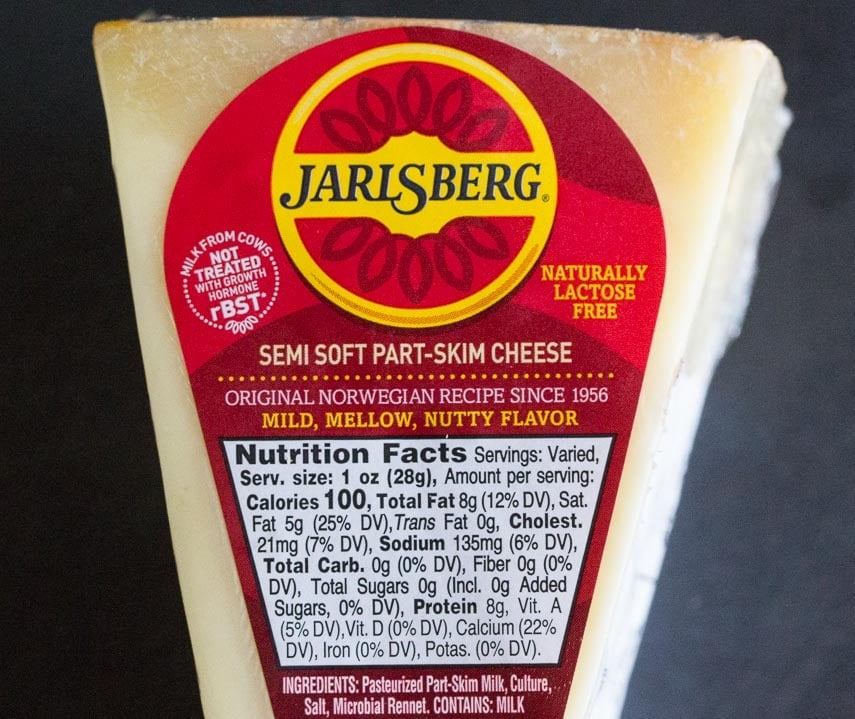
You can see in the image above that the Total Sugars are less than 1 g; this means the serving size of that food is low FODMAP and appropriate even for the Elimination Phase.

Scientific Deductions
And speaking of science, sometimes you can make deductions based upon what is known to determine FODMAP information about an ingredient that has not yet been lab tested.
We recently created a Low FODMAP Blue Cornbread. Blue corn and blue cornmeal have not been lab tested as stand-alone items, so how do I know if our recipe is low FODMAP? I performed a few different kinds of deductions.
First, I found blue corn tortillas in the Monash University app, and they are low FODMAP at 44 g servings. Tortillas are primarily cornmeal and water. If there are additional ingredients, they are usually less than 2% – and yes, I know this from reading labels (constantly; it’s a habit now).
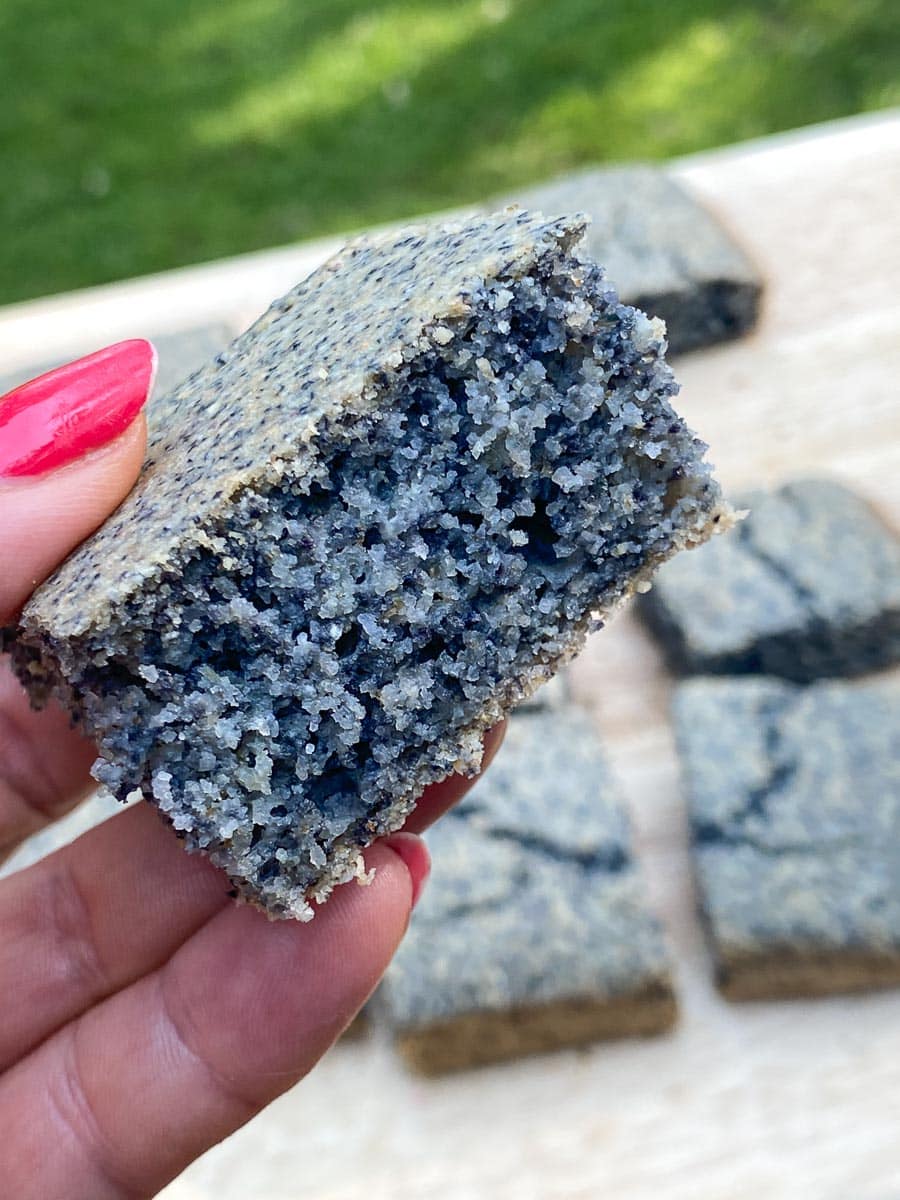
Not All Cornmeal Is The Same
In addition, from label reading you will see that most tortillas are made with masa flour, which is flour that has been processed via nixtamalization. This simply means the corn is exposed to an alkaline solution. Masa harina, which is yellow cornmeal treated in this fashion, has also been lab tested by Monash University and has a very generous serving size of 100 g, or 2/3 cup. Park all of this information to the side for a moment.
Then, I read up on blue corn in general and learned that it is about 20% to 30% higher in protein than yellow or white corn. So, since FODMAPs are carbohydrates, if blue corn is significantly higher in protein, it is therefore lower in carbohydrates, so even though we do not know the exact FODMAP load of blue cornmeal, we know it will be less than yellow cornmeal, which has been lab tested.
Therefore, I based our recommended serving sizes for our Low FODMAP Blue Cornbread on what we do know about blue tortilla serving sizes, the masa harina information, and the high protein statistics of blue corn in general.
I know that that was a lot to digest (so to speak). I can understand if your head is spinning. All we can tell you is that you do have to educate yourself and become your own best advocate.
The Takeaway
The low FODMAP diet can seem confusing at first and learning what to eat – and not eat – does take some studying. It is not necessarily intuitive.
Luckily there are tools that make understanding the diet much easier, in particular the Monash University Low FODMAP Diet App and the FODMAP Friendly smartphone app. It is our opinion that everyone following the diet should have these apps. You will have the most complete, up-to-date information at your fingertips from the originators of the diet. Consider both of these entities as primary resources.
Used correctly, a scanner app, like Fig, used in conjunction with the apps mentioned above, can help you at the supermarket.
Do not rely on Google, Pinterest, Facebook Groups (check who is moderating), or social media in general. In fact, the handouts from your gastroenterologist might be out of date and/or contain incorrect information as well.
You do have to become your own best resource. You will have to educate yourself to label reading and staying on top of new information. The diet is relatively young, and new information is coming out all the time. Foods are re-tested, new products are tested, and new science is released.
But it can be done! Certainly, working with a Registered Dietitian will give you a leg up, but eventually you will be on your own and need to learn how to navigate the world of FODMAPs yourself. The guidance presented here will help you.
